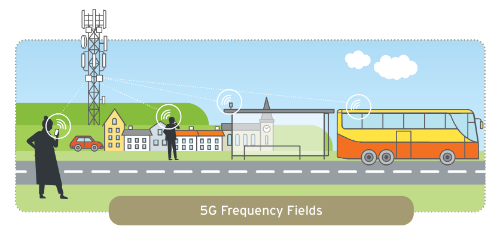5G public exposure and guidelines
How does 5G work?
Initially, 5G networks will make use of existing infrastructure used for previous mobile technologies. The antennas used for 5G are similar to those used for 2G, 3G and 4G and will be installed on masts together with antennas using existing technologies.
Radio waves at the higher 5G frequencies cannot travel as far as those used for 4G (or the lower 5G bands). Therefore, it is envisaged that a large number of smaller antennas using the higher frequencies will be deployed, for example, on lamp posts in urban areas to ensure connectivity.
One distinctive feature of 5G is the ability to generate device-focused beams, known as "beam-forming" and “beam-steering". These allow the signals to be created and directed only when and where they are needed. Pre-5G technologies use continuous beams, similar to broadcast media. Recent simulations indicate that beam-forming and beam-steering technologies could lead to reduced exposure levels from 5G antennas when compared to equivalent 4G equipment, though this needs to be verified using measurements in real-life situations.

Further technical details on 5G and other wireless technologies can be found on this website, developed by several telecommunication associations.
Is 5G expected to increase public exposure to EMF?
The introduction of a new technology using higher frequency RF fields can understandably give rise to concerns. However, it is important to note that higher frequencies do not mean higher or more intense public exposure. The radio frequencies envisaged for 5G are not new. They are in common use today, for example in airport security scanners, radar guns that check traffic speed and in point-to-point microwave links.
Since 5G equipment are being added to existing telecommunication networks, it is possible that there may be a small increase in the overall exposure to radio waves. However, the total or cumulative RF exposure level is expected to remain low and well below international recommendations, such as those issued by ICNIRP.
-400x248.jpg)
In managing the radio spectrum, ComReg monitors compliance with conditions attached to licences and general authorisations. Compliance with the ICNIRP levels is obligatory and reports of EMF measurements from ComReg licensed sites are published on ComReg’s Siteviewer. The ICNIRP guidelines apply to frequencies up to 300 GHz, well above the frequencies envisaged for 5G.
In order to inform our advisory function, the EPA will monitor population exposure to EMF, including the frequencies used and envisaged for 5G. This monitoring programme will also allow us to assess potential increases of the total EMF exposure levels and their comparison with ICNIRP and existing everyday values.
5G is a new technology, are existing guidelines applicable to it?
The introduction of a new technology using existing or new radio frequencies does not change the characteristics of those frequencies. This means that the ICNIRP guidelines which apply up to 300 GHz, well above the frequencies proposed for 5G, remain valid. Therefore, no health effects are expected provided that 5G levels remain below the ICNIRP guidelines for members of the public.
Using a simple analogy, the RF spectrum may be considered as an existing road network. The introduction of a new type of vehicle on to that road does not change the characteristics (or hazards) that are present on the road. Thus, provided that the existing regulations (for that road) such as the speed limits are monitored and enforced no additional risks would be expected from the use of a new type of vehicle on the road. In the same way, the introduction of a new technology like 5G on to existing radio frequencies ought not to increase public risk provided the ICNIRP guidelines are not exceeded.